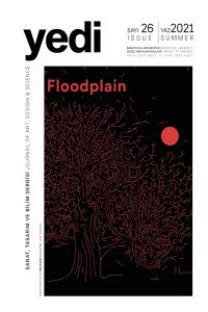Yarı-Şeffaf Dokuma Kumaşların Tasarımı ve Üretiminde Doku Işık Etkileşimi
Dokuma, Kumaş Tasarımı, Şeffaf Kumaş, Şeffaf Doku, Işık
Interaction of Structure and Light in Design and Production of Semi-Transparent Woven Fabrics
Weaving, Fabric Design, Transparent Fabric, Translucent Structure, Light,
___
- Arn-Grischott, Ursina (1997). Doppelgewebe In Der Handweberei, Italy: Verlag Paul Haupt, Die Deutsche Bibliothek
- Atalayer, Günay (2011). “Tekstil Sanatları Eğitiminde Bauhaus’un İzleri Üzerine”. Bauhaus: Modernleşmenin Tasarımı, Türkiye’de Mimarlık, Sanat, Tasarım
- Eğitimi Ve Bauhaus. Der: Ali Artun Ve Esra Aliçavuşoğlu, İstanbul: İletişim Yayınları 1381, Sanat Hayat Dizisi 16
- Güngör, İ. Hulusi (1972). Temel Tasar (Basic Design), İstanbul: Çeltük Matbaacılık Koll. Şti.
- Başer, Güngör (1998). Dokuma Tekniği Ve Sanatı, Cilt1, İzmir: Tmmob Tekstil Mühendisleri Odası Yayınları No.2
- Başer, Güngör (2005). Dokuma Tekniği Ve Sanatı, Cilt2, İzmir: Punto Yayıncılık San. Tic. Ltd. Şti.
- Cole Drusilla (2008). Textiles Now, China: Laurence King Publishing
- Colchester, Chloë (1996). The New Textiles , Trend+Traditions, Singapore: Thames&Hudson
- Cohen, Allen C. & Johnson, Ingrid (2012). J. J. Pizzuto’s Fabric Science, USA: Fairchild Books
- Ellinwood, Janice Greenberg (2011). Fashion By Design, Usa: Fairchild Books, A Division Of Condé Nast Publications
- Gale, Colin & Kaur, Jaspir (2002). The Textile Book, New York: Berg-Oxfort International Publishers Ltd.
- Harris, Jennifer (2006). 5000 Years Of Textiles, China: British Museum Company Ltd.
- Kadolph, Sara & Langford, Anna L. (2002). Textiles, New Jersey: Prentice Hall
- Larsen, Jack Lenor & Weeks, Jeanne (1975). Fabrics For Interiors, A Guide For Architects, Designers, And Consumers, Usa: John Wiley & Sons, Inc.,
- Mccarty, Cara & Mcquaid, Matilda (1998). Structure And Surface, Contemporary Japanese Textiles, The Museum Of Modern Art, New York: Harry N. Abrams Inc.
- Miyokawa, Ritsuko (2000). Suké Suké: The Emperor’s New Fabrics, Nuno Corporation, Takeda Printing Co.,Ltd.
- Quinn, Bradley (2010). Textile Futures: Fashion, Design And Technology, Usa: Berg Publishers
- Önlü, Nesrin (2008). «`Değişen Yüzlü Dokuma Kumaşlarda Farklı Malzeme, Dokuma Tekniği, Örgü ve Renk Kullanımıyla Görsel Etkilerin Elde Edilmesi’”, Tekstil ve Mühendis, Yıl:13, Sayı:64, 9-18 s.
- Önlü, Nesrin (2010). «Research in to Visual Effects of Retro- Reflective Yarns on Weaving Fabrics and Their Relationship with Nano Textiles”, Çeşme: 6th Nanoscience and Nanotechnology Conference, 15-18 June
- Önlü, Nesrin (2010). «Research into Visual Effects of Retro- Reflective Yarns on Weaving Fabrics and Their Relationship with Nano Textiles”, International Journal of Material Science and Electronics Research,Vol1, No.2, July-Dec. 67-74 s.
- Önlü, Nesrin ve Neslihan Yaşar (2011). “Visual Textures Combined with Metallic, Retro-Reflective and Stainless Steel Yarns in Semi-Transparent Fabrics” Research Journal of Textile and Apparel, Vol. 15 No.1, Chemical Abstracts Service (CAS), Textile, 22-33 s.
- Thorne, Down (2009). Transparency in Textiles, Londra: Batsford Thorpe, Azalea Stuart & Larsen, Jack Lenor (1978). Elements Of
- Weaving, A Complete Introduction To The Art And Techniques,
- New York: Doubleday & Company, Inc.
- Wilson, Janet (2010). Classic And Modern Fabrics, The Complete Illustrated, Sourcebook, New York: Thames And Hudson
- Yaşar, Neslihan (2008). “Designing Proporties of Semi- Transparent Fabrics Woven By
- Using Plain Weave and Different Materials” Cirat-3 Proceedings, The Third International Conference of Applied Research in Textile, 13-16 November Tunisia
- ISSN: 1307-9840
- Başlangıç: 2007
- Yayıncı: Dokuz Eylül Üniversitesi
Prof. Dr. Ertan Yılmaz’ın ardından… Saygıyla anıyoruz…
Yarı-Şeffaf Dokuma Kumaşların Tasarımı ve Üretiminde Doku Işık Etkileşimi
Rezerve Boyalı Tekstillerin Gelenekten Modern Tekstil Tasarımları ve Uygulamalarına Dönüşüm Süreci
Başak ÖZDEMİR UYSAL, Günay AYKAÇ ATALAYER
Beral Madra’nın Küratöryal Pratikleri ve Türkiye Sanat Ortamına Katkısı
Halı ve Düz Dokumaların Koruma Uygulamalarında Belgelemenin Önemi ve Tasarımcının Rolü
